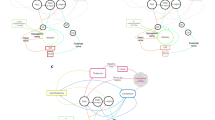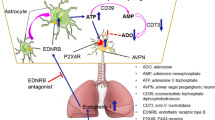Abstract
The present study addressed the question of whether nitric oxide (NO) participates in regulation of osmotic water permeability in the urinary bladder of the frog Rana temporaria L. Experiments were carried out on isolated, paired hemi-bladders filled with amphibian Ringer solution diluted 1:10 with distilled water. Sodium nitroprusside (SNP, 125–250 µM), an NO donor, markedly attenuated the increase of osmotic water flow elicited by arginine-vasotocin (AVT) (AVT 10−10 M: 2.20±0.26; AVT plus 200 µM SNP: 1.21±0.15 µl/min cm2, n=20, P<0.001). This effect of SNP was apparent only in the presence of 50 µM zaprinast, an inhibitor of the cGMP-specific phosphodiesterase-5 (PDE5). In the presence of zaprinast, SNP elevated cGMP production significantly both in control and AVT-stimulated urinary bladders, but had no effect on the level of cAMP (AVT 5×10−10 M: 7.6±0.6; AVT plus SNP 200 µM: 7.5±0.4 pmol/mg protein, n=8, N.S.). 1H-[1,2,4]-oxadiazole-[4,3-a]-quinoxalin-1-one (ODQ, 25–100 µM), an inhibitor of soluble guanylate cyclase, enhanced the AVT-induced water flow, decreased the SNP-stimulated increase of cGMP in the bladder tissue and almost abolished the inhibitory effect of SNP on the AVT-induced hydroosmotic response. 8-(p-Chlorophenylthio)-cGMP (8-pCPT-cGMP, 25 or 50 µM), a membrane-permeable cGMP analogue specific for cGMP-dependent protein kinase (PKG), inhibited, whereas 2 µM KT-5823, an inhibitor of PKG, significantly stimulated the increase of water flow induced by AVT. The inhibitory effect of SNP on AVT-induced water flow was almost completely reversed by KT-5823, but not by 50–100 µM erythro-9-[2-hydroxy-3-nonyl]adenine (EHNA), an inhibitor of cGMP-activated PDE2. Immunohistochemistry of urinary bladder slices with antibodies against different types of NO synthase (NOS) revealed a positive immunostaining for neuronal NOS (nNOS) in the mucosal epithelium. These results suggest that in the frog urinary bladder endogenous NO is involved in regulation of water osmotic permeability. NO inhibits the AVT-induced increase of water flow at least partly by activation of PKG, which interferes with the hydroosmotic effect of AVT probably at (a) post-cAMP step(s).









Similar content being viewed by others
References
Beavo JA (1995) Cyclic nucleotide phosphodiesterases: functional implications of multiple isoforms. Physiol Rev 75:725–748
Bentley PJ (1958) The effects of neurohypophyseal extracts on water transfer across the wall of the isolated urinary bladder of the toad Bufo marinus. J Endocrinol 17:201–209
Bouley R, Breton S, Sun T-x, McLaughlin M, Nsumu NN, Lin HY, Ausiello DA, Brown D (2000) Nitric oxide and atrial natriuretic factor stimulate cGMP-dependent membrane insertion of aquaporin 2 in renal epithelial cells. J Clin Invest 106:1115–1126
Bradford MM (1976) A rapid and sensitive method for the quantitation microgram quantities of protein utilizing the principle of protein dye binding. Anal Biochem 72:248–254
Butt E, Nolte C, Schulz S, Beltman J, Beavo JA, Jastorff B, Walter U (1992) Analysis of the functional role of cGMP-dependent protein kinase in intact human platelets using a specific activator 8-para-chlorophenylthio-cGMP. Biochem Pharmacol 12:2591–2600
Chiu T, Reid IA (1996) Role of cyclic GMP-inhibitable phosphodiesterase and nitric oxide in the beta adrenoceptor control of renin secretion. J Pharmacol Exp Ther 278:793–799
Garcia NH, Pomposiello SI, Garvin JL (1996) Nitric oxide inhibits ADH-stimulated osmotic water permeability in cortical collecting ducts. Am J Physiol 270:F206–F210
Garcia NH, Stoos BA, Carretero OA, Garvin JL (1996) Mechanism of the nitric oxide-induced blockade of collecting duct water permeability. Hypertension 27:679–683
He H, Podymow T, Zimpelmann J, Burns KD (2003) NO inhibits Na-K-2Cl-cotransport via a cytochrome P-450-dependent pathway in renal epithelial cells (MMDD1). Am J Physiol 284:F1235–F1244
Hidaka H, Kobayashi R (1992) Pharmacology of protein kinase inhibitors. Annu Rev Pharmacol Toxicol 32:377–397
Hirsch JR, Cermak R, Forssmann W-G, Kleta R, Kruhoffer M, Kuhn M, Schafer JA, Sun D, Schlatter E (1997) Effects of sodium nitroprusside in the rat cortical collecting duct are independent of the NO pathway. Kidney Int 51:473–476
Kerschbaum HH, Huang S, Mingqiang X, Hermann A (2000) NADPH-diaphorase activity and nitric oxide synthase activity in the kidney of the clawed frog, Xenopus laevis. Cell Tissue Res 301:405–411
Lahera V, Salom MG, Miranda-Guarrdiola F, Moncada S, Romero JC (1991) Effects of N G-nitro-L-arginine methyl ester on renal function and blood pressure. Am J Physiol 261:F1033–F1037
Lee EYW, Humphreys MH (1996) Phosphodiesterase activity as a mediator of renal resistance to ANP in pathological salt retention. Am J Physiol 271:F3–F6
Majid DS, Williams A, Kadowitz PJ, Navar LG (1993) Renal responses to intra-arterial administration of nitric oxide donor in dogs. Hypertension 22:535–541
Mehats C, Andersen CB, Filopanti M, Jin S-LC, Conti M (2002) Cyclic nucleotide phosphodiesterases and their role in endocrine cell signaling. Trends Endocrinol Metab 13:29–35
Mori T, Dickhout JG, Cowley AW Jr (2002) Vasopresssin increases intracellular NO concentration via Ca2+ signaling in inner medullary collecting duct. Hypertension 39:465–469
Omachi RS, Robbie DE, Handler JS, Orloff J (1974) Effects of ADH and other agents on cyclic AMP accumulation in toad bladder epithelium. Am J Physiol 226:1152–1157
Orloff J, Handler JS (1962) The similarity of effects of vasopressin, adenosine-3,5-monophosphate (cyclic AMP) and theophylline in the toad bladder. J Clin Invest 41:702–709
Ortiz PA, Garvin JL (2001) NO inhibits NaCl absorption by rat thick ascending limb through activation of cGMP-stimulated phosphodiesterase. Hypertension 37:467–471
Piccini Z, Parisi M (1973) Effect of guanosine-3’-5’-monophosphate on the hydroosmotic activity of adenosine-3’-5’-monophosphate in toad urinary bladder. Biochim Biophys Acta 311:625–629
Schnackenberg C, Patel AR, Kirchner KA, Granger JP (1997) Nitric oxide, the kidney and hypertension. Clin Exp Pharmacol Physiol 24:600–606
Star RA, Nonoguchi H, Balaban R, Knepper MA (1988) Calcium and cyclic adenosine monophosphate as second messengers for vasopressin in the rat inner medullary collecting duct. J Clin Invest 81:1879–1888
Wang X, Lu M, Gao Y, Papapetropoulos A, Sessa WC, Wang W (1998) Neuronal nitric oxide synthase is expressed in principal cell of the collecting duct. Am J Physiol 275:F395–F399
Acknowledgements
The work was supported by grants from a Russian Fund of Fundamental Research (01-04-49609).
Author information
Authors and Affiliations
Corresponding author
Rights and permissions
About this article
Cite this article
Fock, E.M., Lavrova, E.A., Bachteeva, V.T. et al. Nitric oxide inhibits arginine-vasotocin-induced increase of water osmotic permeability in frog urinary bladder. Pflugers Arch - Eur J Physiol 448, 197–203 (2004). https://doi.org/10.1007/s00424-003-1233-6
Received:
Accepted:
Published:
Issue Date:
DOI: https://doi.org/10.1007/s00424-003-1233-6




